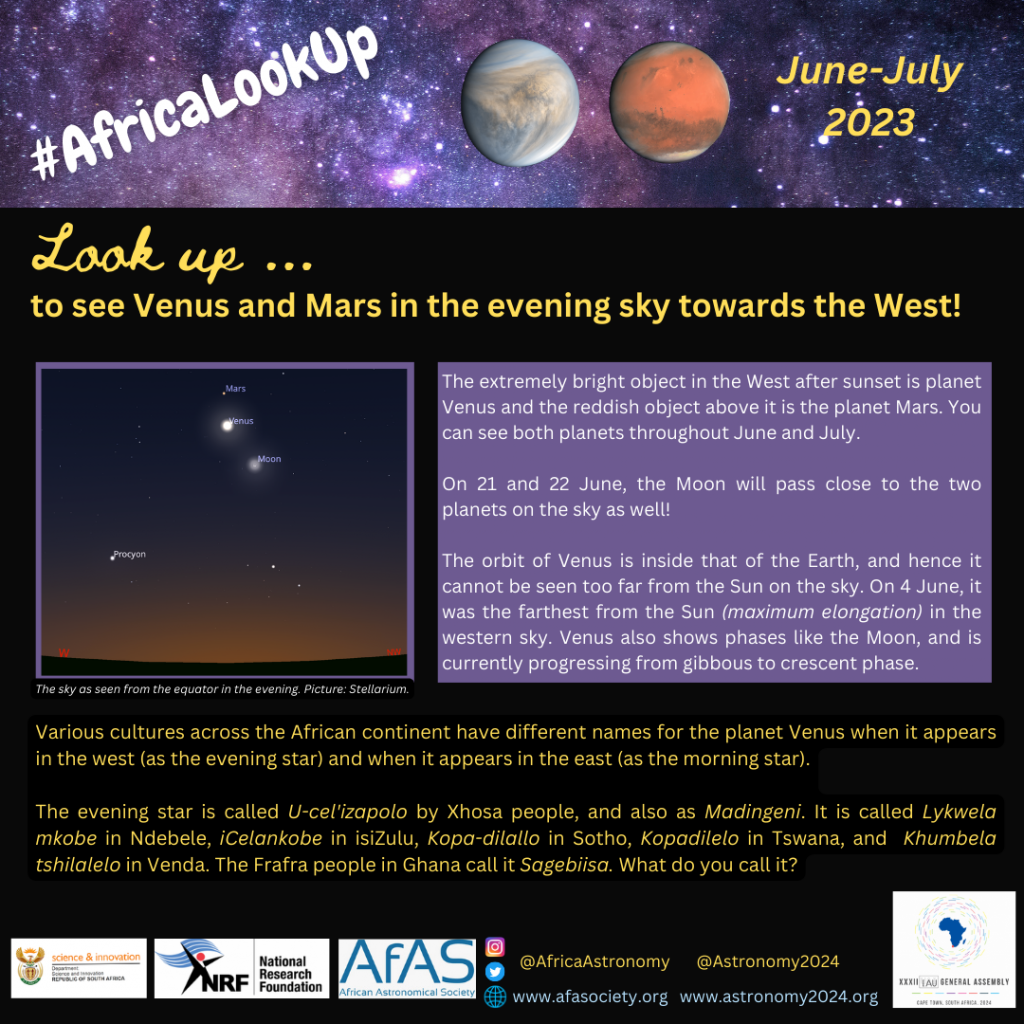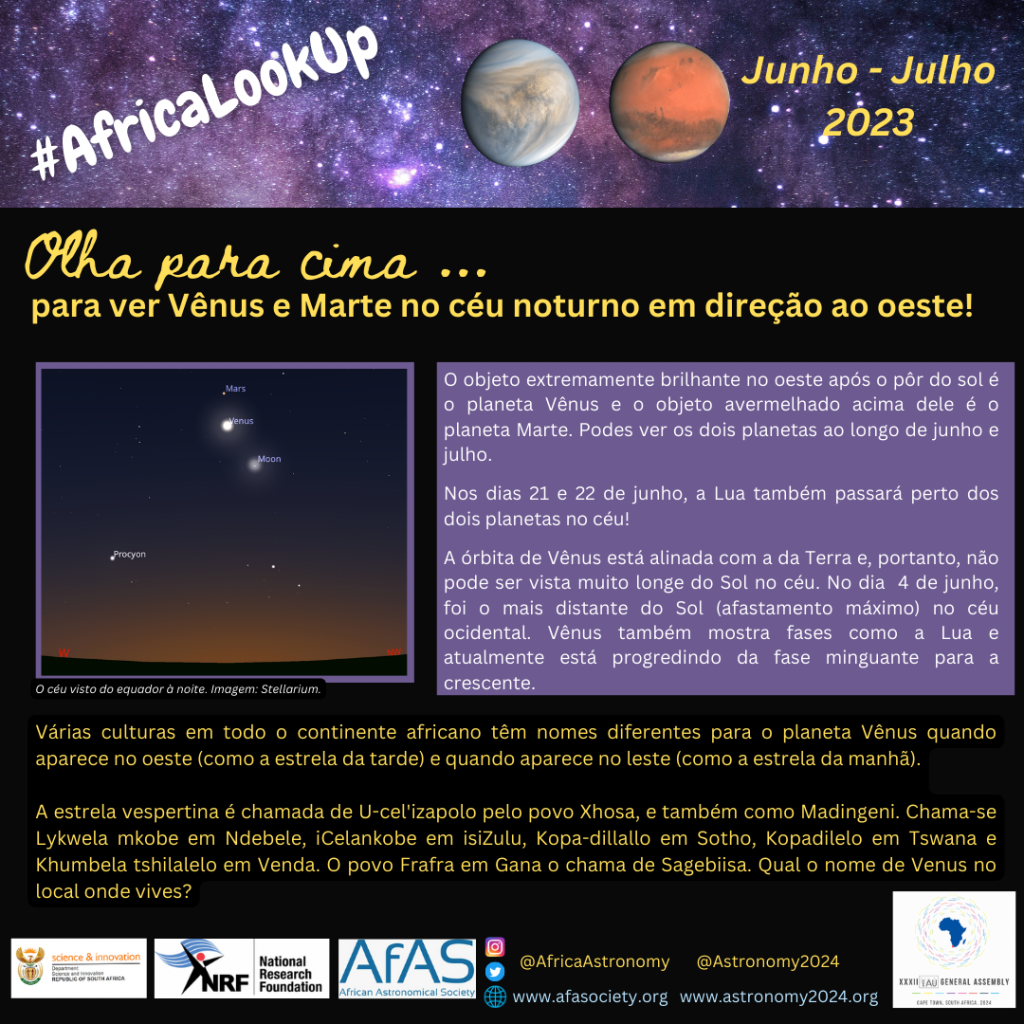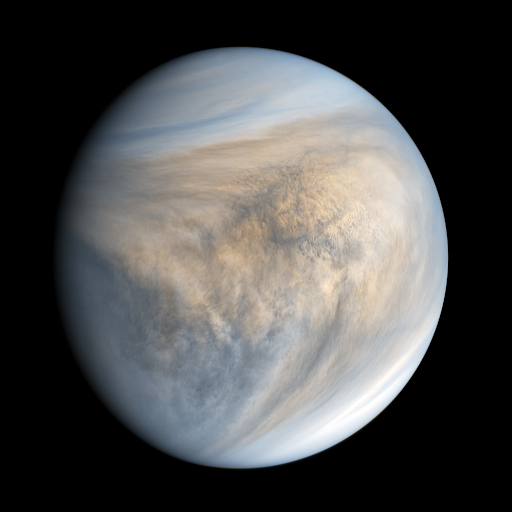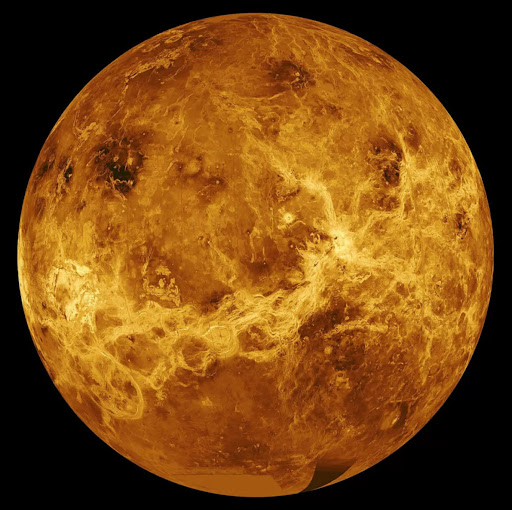#AfricaLookUp
Venus and Mars in June/July 2023
Look up at the evening sky in the west after sunset, and the extremely bright object you will see is the planet Venus, at its maximum separation from the Sun as seen from Earth. Just above it can be seen the reddish coloured planet Mars as well. On 22 June, the crescent Moon will be close to them too.
Our posters

In Portuguese (translated by Marco Romero, for Angola):

When and where can you see Venus?
Venus is the second closest planet to the Sun, and its orbit is inside the orbit of the Earth. Therefore, it can never be seen too far away from the Sun. When Venus is farthest from the Sun as seen from Earth, it is at maximum elongation. This is on 4 June in 2023.
Currently, Venus is at its greatest elongation East of the Sun, and therefore sets after the Sun. It is the brightest object in the sky, after the Sun and Moon, so you can’t miss it!
In June, you can also see the reddish planet Mars just above Venus!
About Venus


Left: Ultraviolet image of Venus by space craft Akatsuki. Right: Radar map of the surface of Venus by space craft Magellan
Venus is a rocky planet with a dense atmosphere, and is almost as large as the Earth. Its atmosphere is mainly Carbon dioxide, which has created a strong greenhouse effect, including sulphuric acid clouds! The temperature at the surface is about 450 degrees Celsius, and the pressure is more than 90 times that of the Earth.
Venus orbits the Sun every 224.7 days and it rotates around its axis every 243 days, but in the opposite direction compared to Earth. Twice every 19 months, it appears farthest from the Sun as seen from Earth, once eastwards, and once westwards of the Sun. Venus shows phases like the Moon, since it shines by reflected light from the Sun. This discovery was used by Galileo as evidence that the planet revolved around the Sun and not around the Earth.
The first probe to pass by Venus was Mariner 2 in 1962, followed by a number of Venera space crafts that landed on its surface. Magellan, Messenger, and Venus Express space crafts have since provided detailed maps of the surface of Venus, with its large volcanic plains, two continents, as well as craters and mountains.
Venus in African Astronomy
When Venus is seen in the western sky after sunset, it is sometimes referred to as the “Evening Star”. Different African cultures have various names and associations for this celestial body. Among the Xhosa people, it is known as U-cel’izapolo or “One Who Asks for Milk from a Teat,” as it signalled the time for boys to return home and milk the cows. It is also referred to as Madingeni or “The Dating Star,” as it was a signal for secret get-togethers between boys and girls. Other African groups linked the appearance of Venus in the evening with supper time, using names like Lykwela mkobe (Ndebele) or iCelankobe (Zulu) meaning “Asking for Mielies”; or Kopa-dilallo (Sotho), Kopadilelo (Tswana), and Khumbela tshilalelo (Venda) meaning “Asking for Supper”.
In the morning, when Venus is visible before sunrise, it is called the “Morning Star” or iKhwezi in Xhosa. The Herero people refer to it as okanumaihi or “Little Drinker of Sweet Milk” due to its appearance during milking time. The Nyae Nyae !Kung Bushmen called it the “Old Star” and believed it guided the Sun across the sky. In Xhosa tradition, it is known as iKhwezi Iokusa and is associated with diligence. Travellers would wake up and resume their journey upon seeing the Morning Star, while young women and girls would start their daily chores.
The Frafra people of the Upper East region of Ghana call Venus “Belumŋwa’arɛ” when it is seen in the morning, which means “breaking the day”. When seen in the evening it is called “Sagebiisa” which means “coming to eat the evening meal of sagbo” (sagbo is a much-loved traditional food made from millet flour).
To read more African starlore about Venus and other celestial objects , see the book “Venus Rising” written by Peter G. Alcock (First Edition, 2014).
Questions to ask
- What colour is Venus in the sky?
- Mars and Venus appear close together in the sky in June. Do they really get close together in space too?
- Do you think we can see Venus in the sky at midnight?
- Do you think life can survive on the surface of Venus?


#AfricaLookUp
Let us look at the skies together!
Let’s celebrate the largest gathering of astronomers in the world in Cape Town in 2024!

Website: https://astronomy2024.org/ Twitter: https://twitter.com/astronomy2024 Instagram: https://www.instagram.com/astronomy2024
